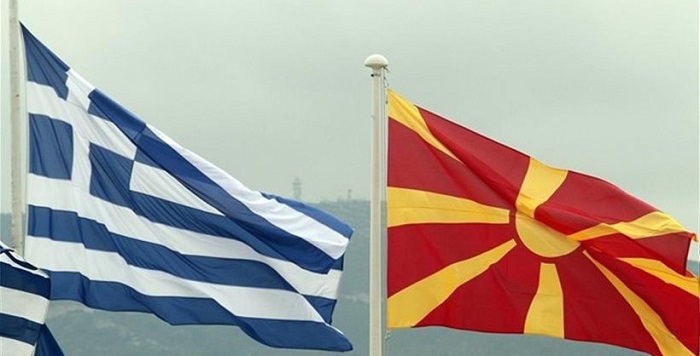By Stephen G. Miller*
The name of the modern land-locked country north of Greece, with its capital at Skopje, has returned to the news. It is officially called FYROM, but embedded in that name is “Macedonia” which is a reflection of the longstanding attempt to take over the modern Greek province of Macedonia as reflected in maps used in many places, including schools.
It is clear that this naming implies territorial ambitions which have long been understood (http://macedonia-evidence.org/documentation.html). If that threat to the stability of the southern Balkans is to be stopped permanently, I suggest that the following must happen:
1) the country should be named Paionia (aka Paeonia) as it was 2500 years ago (see http://macedonia-evidence.org/).
The land in question, with its modern capital at Skopje, was called Paionia in antiquity. Mts. Barnous and Orbelos (which form today the northern limits of Greece) provide a natural barrier that separated, and separates, Macedonia from its northern neighbor. The only real connection is along the Axios/Vardar River and even this valley “does not form a line of communication because it is divided by gorges.”
The geographic situation is made clear by Livy’s account of the creation of the Roman province of Macedonia in 146 B.C. (Livy 45.29.7 and 45.29.12). The land north of Mt. Barnous and Mt. Orbelos was inhabited by Paionians. The natural barrier formed by these mountains must be acknowledged. Barnous (modern Voras or Kaimaktsalan) reaches a height of 2524 meters, while Orbelos (the whole range extending to east and west of the Strymon; the western ridge is the modern Beles or Kerkini with a height of 1474 meters) has a maximum height toward the east of 2211 meters.
Strabo (7. frag 4), writing a few years before the birth of Christ, is even more succinct in saying that Paionia was north of Macedonia and the only connection from one to the other was (and is today) through the narrow gorge of the Axios (or Vardar) River.
The ancient Paionians may or may not have been Greek, but they certainly became ‘Greekish’, and they were never Slavs. They were also not Macedonians. Ancient Paionia was a part of the Macedonian Empire. So were Ionia and Syria and Palestine and Egypt and Mesopotamia and Babylonia and Bactria and many more. They may thus have become “Macedonian” temporarily, but none was ever “Macedonia”. The theft of Philip and Alexander by a land that was never Macedonia, cannot be justified.
The traditions of ancient Paionia could be adopted by the current residents of that geographical area with considerable justification. But the extension of the geographic term “Macedonia” to cover southern Yugoslavia cannot. Even in the late 19th century, this misuse implied unhealthy territorial aspirations.
Unfortunately relatively little is known about the ancient Paionians, partly because “no Paionian Philip ever dominated Greece, and no Paionian Alexander ever conquered the known world” ( Irwin L. Merker, “The Ancient Kingdom of Paionia,” Balkan Studies 6 (1965) 35).
Nonetheless, they appear already in the Trojan War (albeit on the Trojan side; Homer, Iliad 2.848-850, 16.287-291, 17.348-351). Their confrontation with the Persians is recorded by Herodotus (5.1, 12-17). They fought against Philip who subdued them and with Alexander against the Persians, especially in the Battle of Gaugamela in 331 B.C. (Quintus Curtius, History of Alexander 4.9.24-25).
They enjoyed, even under the Macedonians, a certain degree of autonomy as is shown by their negotiations with Athens (IG II2 127), and the many coins minted under a series of Paionian kings, whose names are Greek and inscribed in Greek on the coins. See, for example, the following silver issue of Patraos, probably depicting the slaying of a Persian satrap by the Paionian Ariston, as told by Quintus Curtius (above).
Even more significantly for the assimilation of Paionia into the Greek world are the dedications of statues of Paionian kings made at Delphi and Olympia, and especially the bronze head of a Paionian bison, also at Delphi. See BCH 1950:22, Inschriften von Olympia 303; and Pausanias 10.13.1, respectively.
2) the flag with the Macedonian star must be replaced. That symbol is known only in ancient Greek contexts. Perhaps the symbol of Paionia could be the flower named for it: peony.
3) maps used in public places and schools must cease to show a unified “Macedonia” stretching southward to Mt. Olympus and including Thessaloniki.
This prohibition should include such irredentist maps such as that used in an 8th grade history book in 2005 (and perhaps still today), that shows parts of “Macedonia” occupied by Albania (yellow), Bulgaria (purple), and Greece (red).
The use of suggestive commercial devices such as bank notes with the White Tower of Thessaloniki, must be stopped.
The same should be enforced for materials such as coffee sold under the name of Pella – the capital of ancient Macedonia and birthplace of Alexander – with a sailing ship as its symbol. What is implied thereby for a country which has no seaport?
4) The modern statues of Alexander and Philip recently erected by the Skopjean government must be razed. They are an insult to history. Could Alexander have read the Slavic inscriptions on those statues?
Although there will certainly be those in Skopje who will resist such reforms, I believe that they are absolutely necessary if Greece and Paionia are to live in peace. I also believe that the natives of that land would feel a greater sense of security knowing that their identity was not stolen from another.
PS: There is another solution: Greece annexes Skopje.
*Stephen G. Miller, Professor emeritus, University of California, Berkeley
See all the latest news from Greece and the world at Greekreporter.com. Contact our newsroom to report an update or send your story, photos and videos. Follow GR on Google News and subscribe here to our daily email!









